Anemia is a condition that can affect children of all ages, leaving parents concerned and searching for answers. Pediatric anemia, which refers to a lower-than-normal red blood cell count in children, is a common condition with various underlying causes. Understanding the signs, causes, and treatments can help parents and caregivers ensure their children receive the proper care and thrive.
Recognizing the Signs of Pediatric Anemia
Detecting anemia in children can be challenging, as symptoms often develop gradually. However, there are common signs that parents should look out for:
- Fatigue and Weakness: Children with anemia may feel tired or have reduced energy levels, affecting their ability to play and engage in daily activities.
- Pale Skin: A noticeable pallor, especially around the face and hands, can indicate a reduced red blood cell count.
- Irritability: Anemia may cause mood changes, leading to increased irritability or fussiness.
- Shortness of Breath: Children might experience difficulty breathing during physical activities.
- Slow Growth and Development: In severe cases, anemia can affect physical and cognitive development.
- Cold Hands and Feet: Reduced oxygen circulation may lead to a sensation of cold extremities.
If your child exhibits these symptoms, it’s essential to consult a healthcare professional for an accurate diagnosis.
Common Causes of Pediatric Anemia
Understanding the causes of anemia in pediatrics is crucial for effective treatment. Pediatric anemia can stem from several factors:
- Iron Deficiency: This is the most common cause of anemia in children. It occurs when the body lacks enough iron to produce adequate hemoglobin.
- Nutritional Deficiencies: Besides iron, deficiencies in vitamins such as B12 and folate can contribute to anemia.
- Chronic Illnesses: Conditions like kidney disease or inflammatory disorders can interfere with red blood cell production.
- Blood Loss: Gastrointestinal bleeding, heavy menstrual periods in adolescents, or injuries can lead to anemia.
- Genetic Disorders: Conditions like sickle cell anemia or thalassemia are inherited and affect red blood cell function or production.
- Infections: Certain infections, such as malaria, can destroy red blood cells, leading to anemia.
Each child’s case is unique, making it essential to identify the specific causes of pediatric anemia through medical evaluation.
Diagnosis and Pediatric Anemia Guidelines
Diagnosing pediatric anemia typically involves a thorough medical history, physical examination, and blood tests. The following steps are part of standard guidelines:
- Complete Blood Count (CBC): This test measures red blood cell count, hemoglobin levels, and other critical parameters.
- Iron Studies: These tests assess iron levels, ferritin, and transferrin saturation to diagnose iron deficiency anemia.
- Additional Tests: In some cases, tests for vitamin deficiencies, genetic markers, or chronic diseases may be required.
Following pediatric anemia guidelines ensures that healthcare providers can accurately identify the type and severity of anemia, enabling targeted treatment.
Effective Treatments for Pediatric Anemia
Treatment for anemia in children depends on its cause and severity. Here are some of the most effective approaches:
1. Dietary Modifications
A balanced diet rich in essential nutrients can prevent and treat mild anemia. Include iron-rich foods such as:
- Lean meats (e.g., chicken, turkey, beef)
- Leafy green vegetables (e.g., spinach, kale)
- Legumes (e.g., lentils, chickpeas)
- Iron-fortified cereals and bread
Pairing these foods with vitamin C sources (like oranges or strawberries) enhances iron absorption.
2. Iron Supplements
In cases of iron deficiency anemia, pediatric iron doses for anemia are prescribed. It is vital to follow the dosage recommendations provided by a healthcare professional, as excessive iron intake can be harmful.
3. Addressing Underlying Causes
For anemia caused by chronic illnesses or genetic disorders, managing the underlying condition is key. This may involve specialized treatments or medications.
4. Blood Transfusions
In severe cases of anemia, especially those due to blood loss or inherited disorders, blood transfusions may be necessary to restore healthy red blood cell levels.
5. Vitamin Supplementation
For children with deficiencies in vitamins B12 or folate, supplements can help restore normal levels and improve anemia symptoms.
Prevention of Pediatric Anemia
Preventing anemia is often easier than treating it. Parents can take proactive steps to reduce the risk of pediatric anemia:
- Ensure a Balanced Diet: Incorporate iron-rich and nutrient-dense foods into your child’s meals.
- Regular Check-Ups: Routine pediatric check-ups can help detect anemia early, even before symptoms arise.
- Follow Vaccination Schedules: Protecting children from infections that can cause anemia is an essential preventative measure.
- Avoid Excessive Cow’s Milk: In young children, too much cow’s milk can interfere with iron absorption.
Read More : Anemia: Types, Symptoms, and Risk Factors
The Human Touch: Supporting Your Child
Dealing with pediatric anemia can be overwhelming for both parents and children. Emotional support and open communication are vital throughout the treatment process. Encourage your child to share how they feel, and reassure them that with proper care, they can overcome anemia and regain their energy.
It’s also crucial for parents to stay informed. Understanding pediatric anemia guidelines and being aware of the appropriate pediatric iron dose for anemia can empower families to make well-informed decisions.
When to Seek Immediate Help
While most cases of pediatric anemia are manageable, severe symptoms such as chest pain, rapid heartbeat, or difficulty breathing require immediate medical attention. These could indicate a more critical condition that needs urgent care.

